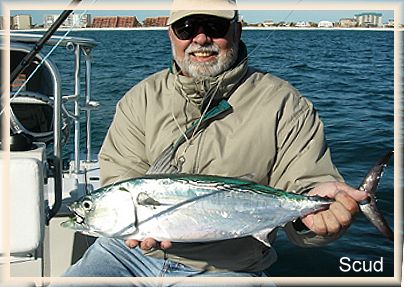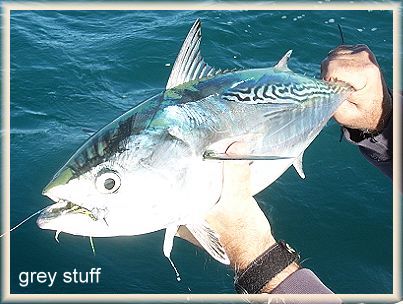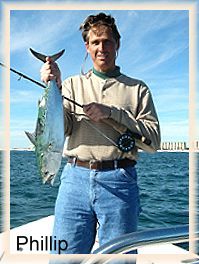Winter fly-fishing around the Panhandle of
Florida is often tough on the fingers with
the cold, and the spirits, with reluctant
fish. If you don't get the tide just right
for the few warm spots the fish hold in, a
day can be pretty sorry. It can also get
crowded at one good spot since a local guide
took a magazine writer out and showed him "our"
spot. He published a story with pictures and
maps. Smart. Now, fifty boats can be found
in the one-acre "pond" where only a couple was
the standard for years. Most of the "new" users
of the spot are killing the fish too. It did not
seem fair to bother too many poor fish trying to
keep warm in the winter but to kill them too is a
real disrespect. We use to catch a few easy ones
and then press off for the more difficult flats
wandering ones.
Every once in a while you get a surprise in the
cold months like the time my son and I found a big
black drum under our sailboat during a boat project.
We got lucky this winter a couple of weeks back,
probably because we were not looking for fish.
I got a call from a friend, Philip, who lost his
mast and jib sail in the Destin Pass on the 29th of
December. It was a near death experience when the
shroud came unglued in heavy seas. He and his brother
barely made it past the rock weir, and then, surfed
the hulls of his 20-foot catamaran onto the beach with
the coast guard closing in on a rescue. Both sailors
looked like hamburger after the battering but will
probably not have permanent scars.
The mast had a floating tip and about $1000 worth
of gear he needed to repair the boat. He thought
it might be "bobbing" out near the pass or may have
washed up on shore down-tide from the accident site.
I tried to tell him that I had done something about
the same once and finding the gear would be like
getting a democrat elected in this county. Impossible.
Poverty drove the search and him not knowing any other
boat owner in the area brought me into the act.
The weather he crashed in was not all over and
although my new Hell's Bay Marquesa is supposed
to take heavy water, the wind was still out of
the north at 17 gusts to 24 when we launched.
It was also about 43 degrees making the chill
factor turn flying water into slush. The trip a
few miles across open bay water was "interesting."
We were dressed like Michelin men and managed to
keep relatively dry. The boat worked as advertised,
mighty good in the two-foot chop with the tops of
the waves blowing off. Once out of the pass and
protected by the shore somewhat, the waves stopped
and all we had to contend with was the five foot
swells and forming breakers over the sandbars near
shore.
Search we did, on a couple mile run to the west
staying far enough from the backs of the breaking
waves but near enough to see the shore and shallows
where the mast might be "bobbing." Nothing. We
drove back, out a half-mile, to check the deeper
water but that took us back to the waves again with
the increased fetch from the shore. Three hours of
searching found us back in Destin harbor looking for
some coffee. Philip covered a lunch for the pain
and suffering he took me though. He even admitted
the search was probably close to useless. I had a
beer just to get the courage up to go back upwind
across the bay on the way home.
Once on the water again, conditions had laid down
some. The wind was probably only 12 gusting to 18
and dropping. Philip forgot the part of "probably
being useless" and wanted to go east out in the
ocean again. I agreed (the beer fogged my brain)
to go to the mouth of the pass and 'look at the
conditions.' In the opening it was not "too bad,"
so we blasted out turning east. I was going to humor
him for another hour and hoped the wind dropped more
for the trip upwind home.
Just then, about a quarter mile out from us, birds
started going wild over a wide spot on the water.
That is the usual summer sign of fish eating but
the water was just about 55 degrees and that is a
little cold for most fish in this area. These were
terns too, and they are known to lie sometimes.
We sped over and sure enough fish were busting
and birds were diving to pick up the pieces. I
couldn't tell what kind yet but suspected some
thing in the tuna family as they move fast enough
to keep warm.
Being a good fisherman I never leave home without
some gear. I had a small four weight rigged in the
side pole holders with a little clouser fly on it
as we had been fishing for small trout recently and
that was all I expected to find around if anything.
Philip was offered the rod but looked at the pitching
deck and the wind and asked me 'to show him the
technique.' He is an avid fly fisherman but has
never tried saltwater. As I stripped out the line
we arrived in the fish bundle. As I tossed I could
see the ten-pound tuna style "footballs" flashing
past and when the fly was eaten I knew the rod was
going to be too small to handle the fish. Being a
tuna type, the take is quick and the first run is fast.
I could do nothing with the rod tip and little with
the butt of the light rod. I tightened the drag to
slow it down but still could not raise the rod much
without breaking it. It was like hand line fishing
and the eight-pound leader snapped, not a bad outcome
in the situation.
Fish were still busting all around as I handed that
rod to Philip to stow and started building the seven
weight I had thrown in at the last minute to have a
back up. Still not all the rod optimally for the
conditions or fish, but much better than a four weight.
Rigged with another small yellow and white clouser,
I handed it to Philip. He had the idea and was more
than willing to go for it after the first demo.
The fish were boiling and roaming in big circles
eating something near the surface and if we idled
to the front of the flow the four-stroke Suzuki
engine did not seem to spook them. We'd shut down
then and glide waiting for the fish to get close
enough. The first time the whole school turned
toward us Philip was false casting so many times
they were gone before the fly hit the water. I
was telling him the fish couldn't get to it unless
it was in the water and the next cast was just about
perfect and he was hooked up. Off the fish ran and
perhaps I had set the drag a little heavy. The fish
came unbuttoned. He stripped in and started to cast
again but I stopped him to look at the fly. Sure
enough the hook was straightened out 90 degrees.
It was a number eight Mustad 34007 which is stainless
and not all that strong. I now had wasted two fish
with the wrong gear.
I put on a large clouser, at least a number two hook
and tried to put Philip back on the front. He said
it was my turn so I reluctantly accepted. He positioned
the boat well and I got three shots that should have
produced a hook up. It was the size of hook that
mattered, so now I had lost more opportunities
through bad decisions. I was glad this was a rescue
mission instead of a charter as I was feeling like
a buffoon. With a little clouser back on with the
correct strength hook, I hooked up the next cast.
I got the chance to show Philip the complete fight
and landing of one of these little beauties and after
a picture, he gladly picked up the rod again.

He still wanted to false cast over the fish while
they raced by. That must be what trout fishermen
do a lot of. When he got it in the water the fish
took it. This, his first saltwater fish, did all
it should have to him. It took him into the backing
so I idled the boat after the fish to get back on
the fly line. This takes the backing to line knot
out of the fight so you don't lose a whole line if
it fails. Once the run or runs are over, the fish
comes by and sees the boat and then the rest of the
fight in straight down from the bottom. We were
in about 40 to 60 feet of water so this can take
a bit of tugging. I talked him into not bending
the rod and fighting from the butt of the pole and
then had to get him to not "help" by using his other
hand on the rod above the handgrip. This also ends
in breakage while trying to pull up a deep heavy fish.
You have to wait it out and get line back as you can.
Finally, after he made several trips all around the
boat with the tip in the water fighting the fish under
and around the boat we got a flash of the fish turning
on its' side, meaning it was finally getting tired.
Once back on the surface it is also hard to stop high
sticking as the technique is to get the tip of the rod
near the fish to "pull" him to the surface rather than
"lifting" him. It was another eight to ten pounder
but this one had a heck of a healed shark bite over
and around his back down his side. He had been slashed
from the top front instead of the rear and his tail
(motor) was still working letting him get away. When
we released him he might have thought he was a cat
with two of the lives used.
That clouser was used for the next three fish until
it was just about trimmed down to nothing and then
we changed to another and continued chasing around
hooking fish. Philip lost another one but the hook
was fine. Some are just not hooked well enough.

Philip did get a bigger one in and while I tried to
get the hook from down deep inside, it puked up an
extensive amount of partly digested gray gunk. At
first it looked like squid but as I scooped the
piles it off the boat and my body, the little
legs were easy to make out. If the shrimp were
on the top of the water we could not see them and
I suspect this fish had them deep in his belly
while he was chasing small glass minnows with
the school.
The fish we were catching were not really bonitos
but instead, false albacore. Philip asked if we
could eat them. I said they were suitable for
the table or grill but not the best around. They
are still dark meat but not as bloody as their
look-alike bonito. Bleed them when you catch
them and they are fine and a really good sushi
if you like the rare style. He declared he
wanted a couple to take back to his vacationing
family. I had a knife and told him we could do
that if he really wanted to.

They heard us! All the birds sat down and fell
asleep and the fish left the area. It had lasted
for about two hours and just stopped. We had not
seen a bird or fish in the run down the beach
before lunch and now it was back to that state.
We headed back with the wind still dropping.
Inside the pass we ran into one more small school
going crazy but were unable to hook one and after
a few tries we bundled up and ran home. The wind
was way down to 10 to 12 and the bay was down to a
one-foot chop. Nothing for this boat to handle
so I ran it up to 5800 RPM and maxed out at about
39 MPH, slowed some by the chop. I bet I got the
chill factor back to the low 20s again to make the
day's end beer seem warm.
Winter is tough on the charter business but being
ready (just "almost" in this case) can make a crappy
day seem a lot better. Philip said, "This salt water
fishing could get me to give up sailing." He liked
the way the fish pulled. If the water gets above
54 degrees and you are dressed for it, we can still
have some fun here. ~ Capt. Scud, Dec 30, 2003
|





